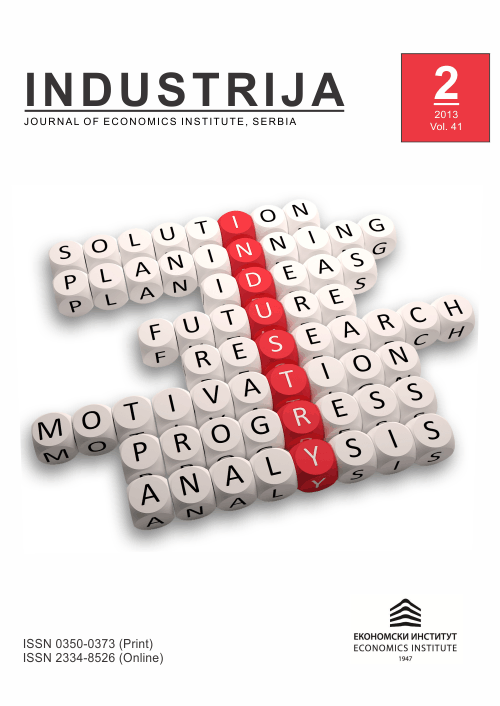Predicting Economic Activity in Serbia By Constructing Serbian Leading Economic Indicator (SERLEI)
Abstract
Timely identification of the next stage of the business cycle, or a shift in economic activity from the previous trend, is a critical factor for the success of counter-cyclical economic policy. This paper is based on the construction of a new leading indicator of the business cycle which, with a certain time lag, suggests the next stage of the business cycle in the Republic of Serbia. SERLEI (Serbian Leading Economic Indicator) is tested in the period of expansion and at the beginning of recession in the Serbian economy to show to what extent it was possible to predict a shift in business cycles
References
Abiad, A. (2003). Early Warning Systems: A Survey and a Regime-Switching Approach, IMF Working Papers 03/32, International Monetary Fund.
Bačić, K., and Vizek M.(2006). A Brand New CROLEI – Do we need a new forecasting index?, Financijska teorija i praksa, 30 (4): 311-346.
Bačić, K., and Vizek M. (2008). Forecasting business and growth cycles in Croatia, Ekonomski pregled, 50 (11) : 646-668.
Belgrade Stock Exchange, www.belex.rs
Brüggemann, A. and Linne T. (1999). How Good are Leading Indicators for Currency and Banking Crises in Central and Eastern Europe? An Empirical Test. IWH Discussion Papers 95, Halle Institute for Economic Research.
Cerra, V. and Chaman Saxena S.(2002). Contagion, Monsoons, and Domestic Turmoil in Indonesia's Currency Crisis. Review of International Economics, Vol. 10, pp. 36-44.
Edwards, S. (1989). Real Exchange Rates, Devaluation and Adjustment: Exchange Rate Policy in Developing Countries, MIT Press Cambridge, MA.
Edwards, S. and Santaella J. (1993). Devaluation Controversies in the Developing Countries; Lessons from the Bretton Woods Era in: A retrospective on the Bretton Woods System: Lessons for International Monetary Reform, pp 405-460, NBER.
Eichengreen, B. et al. (1995). Exchange Market Mayhem: The Antecendents and Aftermath of Speculative Attacks. Economic Policy, Blackwell Publishing, Vol.10, No21: 249-312.
Frenkel, J. A. and Rose A. (1996). Currency Crashes in Emerging Markets: An Empirical Treatment. Journal of International Economics 41, no 3/4:351-366.
Frankel, J. A. and Saravelos G. (2010). Are Leading Indicators of Financial Crises Useful for Assessing Country Vulnerability? Evidence from the 2008-09 Global Crisis. NBER Working Papers 16047, National Bureau of Economic Research, Inc.
Fund for Development of Economics, www.fren.org.rs
Hamilton, J.D. (1989). A New Approach to the Economic Analysis of Nonstationary Time Series and the Business Cycle, Econometrica, Volume 57, No 2: 357-384.
Hawkins, J. and Klau M.(2000). Measuring potential vulnerabilities in emerging market economies. BIS Working Papers 91, Bank for International Settlements.
Kamin, S. (1988). Devaluation, External Balance and Macroeconomic Performance: A Look at The Numbers Princeton Studies in International Economics 62, International Economic Section, Department of Economics Princeton University.
Kaminsky, G., Lizondo S. and Reinhart C. (1998). Leading Indicators of Currency Crisis. IMF Staff Papers, Palgrave Macmillan Journals, vol 45(1).
Martinez Peria, M. (2002). A Regime - Switching Approach to the Study of Speculative Attack: A Focus on EMS Crisis. Empirical Economics, Springer, vol 27(2), pp 299-334.
National Bank of Serbia, www.nbs.rs
Praščević, A. (2009). Ekonomska politika Srbije između svetske ekonomske krize i predizbornih obećanja , Monografija Ekonomska politika Srbije u 2009.godini: izazovi svetske ekonomske krize, Ekonomski fakultet u Beogradu i Naučno društvo ekonomista, Beograd.
Rašić Bakarić, I.,Tkalec M., and Vizek M. (2011). Primjena modelskog pristupa izračunu navješćujućeg kompozitnog indeksa: slučaj CROLEI indeksa, Ekonomski pregled, 62(11), 613-635.
Statistical Office of the Republic of Serbia, www.stat.gov.rs
Vesselinov, R. (2012). New Composite Indicators for Bulgarian Business Cycle. International Journal of Economic Sciences and Applied Research, Volume 5 Issue 2, pp. 101-111. Available at SSRN: http://ssrn.com/abstract=2155592.
Zaman et al. (2011). Ekonometrijska procena i projekcija mesečnih budžetskih prihoda, Priručnik za analizu javnih finansija, str.69-70.

